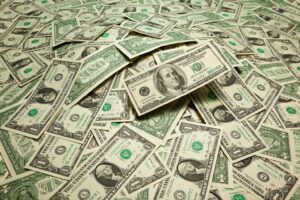A look at the day ahead in U.S. and global markets from Mike Dolan
The U.S. dollar seems to have emerged a clear winner from the week’s magical mystery tour of world central banks – with record high Wall St and world stocks getting a shot across the bow from Apple (NASDAQ:)’s antitrust bust.
A whistle stop look at the week’s multiple central bank readouts shows a surprise rate cut in Switzerland, cuts in Mexico and Brazil and an unusually dovish Bank of England tilt that brings a June UK rate cut into view. And there were promises of more monetary easing to come in China to add to the mix.
Although the Bank of Japan finally set about ‘normalising’ in the other direction, and Taiwan’s central bank delivered a surprise hike too, the overall thrust is a global central bank cycle that has turned before the Federal Reserve kicks off.
While the Fed held the line on Wednesday, as expected, and continued to flag three rate cuts later this year, the slightly hawkish takeaway was that its policymaker projections removed one cut from next year’s ‘dot plot’.
And so with other central banks jumping the Fed gun on the first move and potentially cutting deeper over the coming two years, the dollar has got a shot in the arm.
The hit its highest in over a month on Friday and has now climbed more than 2% from March troughs.
Eye-catching overnight was a swoon in China’s to its weakest level of the year, without any ostensible trigger beyond the dovish soundings from deputy governor of the People’s Bank of China. China’s stocks closed sharply lower too.
But the dollar was pumped up across the board, hitting 2024 highs against the Swiss franc, Japan’s yen and one-month peaks against sterling.
Reflecting a firmer Fed horizon beyond this year, U.S. Treasuries stalled – with two-year yields firming up above 4.60%.
Perhaps strange in an election year, Treasury market volatility measures subsided to their lowest since before the Fed began its tightening campaign two years ago.
The latest U.S. economic readouts continued to show brisk business growth and labor market tightness and markets will now switch attention next Friday’s release of the Fed’s favored PCE inflation gauge.
Buoyant Wall St stocks clocked record closing highs again on Thursday, but Apple’s 4% slide dampened the mood as U.S. antitrust regulators moved in – sending a warning to a market so heavily concentrated in Big Tech megacaps.
Although its stock stabilised overnight, the U.S. Department of Justice and 15 states sued Apple in a government crackdown on Big Tech – alleging the iPhone maker monopolized the smartphone market, hurt smaller rivals and drove up prices.
Apple joins competitors sued by regulators, including Alphabet (NASDAQ:)’s Google, Meta Platforms (NASDAQ:) and Amazon.com (NASDAQ:) across the administrations of both former president Donald Trump and President Joe Biden.
Elsewhere, overnight earnings were mixed.
FedEx (NYSE:) shares surged 13% after the bell after the company narrowed its fiscal 2024 profit forecast and announced share buybacks that help offset less business from its largest customer, the U.S. Postal Service.
But Nike (NYSE:) stock skidded 6% after it warned its revenue in the first half of fiscal 2025 would shrink by a low single-digit percentage as the world’s largest sportswear maker scales back on franchises to save costs.
Key diary items that may provide direction to U.S. markets later on Friday:
* Federal Reserve Chair Jerome Powell, Fed Vice Chair Philip Jefferson, Fed Board Governor Michelle Bowman, Fed Vice Chair for Supervision Michael Barr and Atlanta Fed President Raphael Bostic all speak
* European Central Bank President Christine Lagarde attends Euro Summit in Brussels, ECB chief economist Philip Lane speaks
* Canada Jan retail sales and government budget balance
(By Mike Dolan, editing by Christina Fincher, mike.dolan@thomsonreuters.com)
Read the full article here












